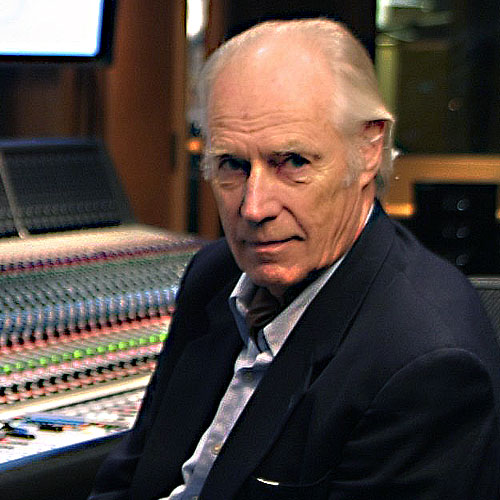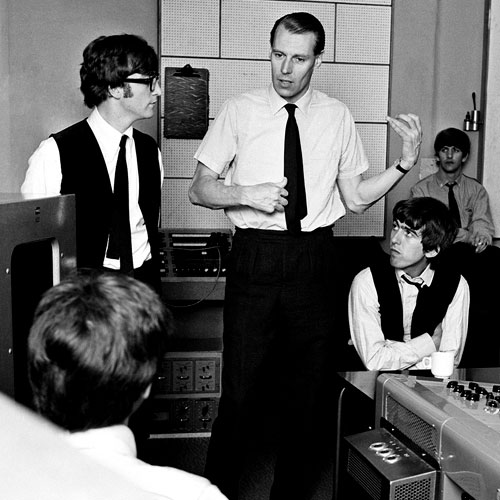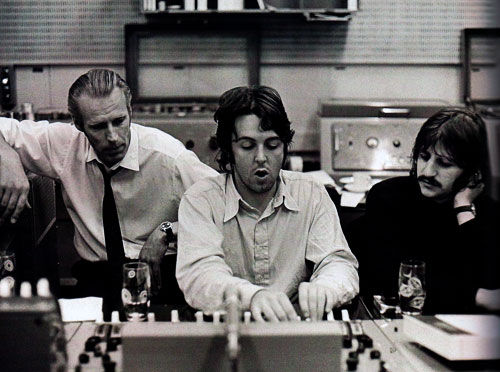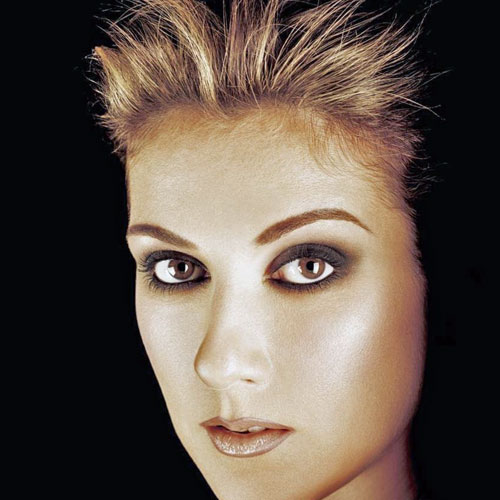George Martin 1926-2016
As An Arranger
Martin’s more formal musical expertise helped fill the gaps between the Beatles’ unrefined talent and the sound that distinguished them from other groups and eventually made them successful. Most of the Beatles’ orchestral arrangements and instrumentation (as well as frequent keyboard parts on the early records) were written or performed by Martin in collaboration with the less musically experienced band. It was Martin’s idea to put a string quartet on “Yesterday”, against McCartney’s initial reluctance. Martin played the song in the style of Bach to show McCartney the voicings that were available. Another example is the song “Penny Lane”, which featured a piccolo trumpet solo. McCartney hummed the melody he wanted, and Martin notated it for David Mason, the classically trained trumpeter.
His work as an arranger was used for many Beatles recordings. For “Eleanor Rigby” he scored and conducted a strings-only accompaniment inspired by Bernard Herrmann. On a Canadian speaking tour in 2007, Martin said his “Eleanor Rigby” score was influenced by Herrmann’s score for the Alfred Hitchcock thriller, Psycho. For “Strawberry Fields Forever”, he and recording engineer Geoff Emerick turned two very different takes into a single master through careful use of vari-speed and editing. For “I Am the Walrus”, he provided a quirky and original arrangement for brass, violins, cellos, and the Mike Sammes Singers vocal ensemble. On “In My Life”, he played a speeded-up baroque piano solo. He worked with McCartney to implement the orchestral ‘climax’ in “A Day in the Life” and he and McCartney shared conducting duties the day it was recorded.
Martin contributed integral parts to other songs, including the piano in “Lovely Rita”, the harpsichord in “Fixing a Hole”, the organs and tape loop arrangement that create the Pablo Fanque circus atmosphere that Lennon requested on “Being for the Benefit of Mr. Kite!” (both Martin and Lennon played organ parts for this song), and the orchestration in “Good Night”. The first song that Martin did not arrange was “She’s Leaving Home”, as he had a prior engagement to produce a Cilla Black session, so McCartney contacted arranger Mike Leander to do it. Martin was reportedly hurt by this, but still produced the recording and conducted the orchestra himself.
Martin was in demand as an independent arranger and producer by the time of The White Album, so the Beatles were left to produce various tracks by themselves. Martin arranged the score for the Beatles’ film Yellow Submarine and the James Bond film Live and Let Die, for which Paul McCartney wrote and sang the title song. He also helped arrange Paul and Linda McCartney’s American Number 1 single “Uncle Albert/Admiral Halsey”. Paul McCartney once commended Martin by saying: “George Martin [was] quite experimental for who he was, a grown-up.”
Film and Composing
Beginning in the late 1950s, Martin began to supplement his producer income by publishing music and having his artists record it. He used the pseudonyms Lezlo Anales and John Chisholm before settling on Graham Fisher as his primary pseudonym.Martin composed, arranged and produced film scores since the early 1960s, including the instrumental scores of the films A Hard Day’s Night (1964, for which he won an Academy Awards Nomination), Ferry Cross the Mersey (1965), Yellow Submarine (1968) and Live and Let Die (1973). Other notable movie scores include Crooks Anonymous (1962), The Family Way (1966), Pulp (1972) starring Michael Caine and Mickey Rooney, the Peter Sellers film The Optimists of Nine Elms (1973), and the John Schlesinger directed Honky Tonk Freeway (1981).
He also composed the David Frost theme “By George”, “Eary-Feary” (the theme from the 1970 LWT horror series Tales of Unease), “Theme One” for BBC Radio 1, “Adagietto for Harmonica & Strings” for Tommy Reilly, and “Magic Carpet” for the Dakotas.
The Beatles Anthology
Martin oversaw post-production on The Beatles Anthology (which was originally entitled The Long and Winding Road) in 1994 and 1995, working again with Geoff Emerick. Martin decided to use an old 8-track analogue deck - which EMI learned an engineer still had - to mix the songs for the project, instead of a modern digital deck. He explained this by saying that the old deck created a completely different sound, which a new deck could not accurately reproduce. He also said he found the whole project a strange experience (and McCartney agreed), as they had to listen to themselves chatting in the studio, 25–30 years previously.
Martin stepped down when it came to producing the two new singles reuniting McCartney, Harrison and Starr, who wanted to overdub two old Lennon demos. Martin had suffered a hearing loss, so he left the work to writer/producer Jeff Lynne of the Electric Light Orchestra.
Cirque du Soleil and LoveIn 2006
Martin and his son, Giles Martin, remixed 80 minutes of Beatles music for the Las Vegas stage performance Love, a joint venture between Cirque du Soleil and the Beatles’ Apple Corps Ltd. A soundtrack album from the show was released that same year.
Public image
Martin’s contribution to the Beatles’ work has received regular critical acclaim and has led to him being described as the “Fifth Beatle”. However, he distanced himself from this claim, stating that assistant and roadie Neil Aspinall would be more deserving of that title. Despite Martin’s experience in working with many different artists, he has been criticised for being perceived as putting too much attention on the Beatles. Howard Stern publicly criticised Martin for receiving too much credit for the group’s success, though this was quickly disputed by others as “ill-judged”. Beatles author Sean Egan thinks his “Fifth Beatle” image has been “overplayed by some”. John Lennon trivialised Martin’s importance to the Beatles’ music. In his 1970 interview with Jann Wenner, Lennon said, “[Dick James is] another one of those people, who think they made us. They didn’t. I’d like to hear Dick James’ music and I’d like to hear George Martin’s music, please, just play me some.”
In a 1971 letter to Paul McCartney, Lennon wrote, “When people ask me questions about ‘What did George Martin really do for you?,’ I have only one answer, ‘What does he do now?’ I noticed you had no answer for that! It’s not a putdown, it’s the truth.” Lennon wrote that Martin took too much credit for the Beatles’ music. Commenting specifically on “Revolution 9″, Lennon said with ironic authority, “For Martin to state that he was ‘painting a sound picture’ is pure hallucination. Ask any of the other people involved. The final editing Yoko and I did alone.”
Other Artists
Martin in 2007. Martin produced recordings for many other artists, including contemporaries of the Beatles, such as Matt Monro, Cilla Black, Gerry & The Pacemakers, Billy J. Kramer & the Dakotas, The Fourmost, David and Jonathan, and The Action, as well as The King’s Singers, the band America, guitarists Jeff Beck and John Williams, sixties duo Edwards Hand, Gary Brooker, Neil Sedaka, Ultravox, country singer Kenny Rogers, Cheap Trick, Elton John, Celine Dion and Yoshiki Hayashi of X Japan. Also working with Gary Glitter before his chart success, Martin recorded several songs with him in the early 1960s, with the singer using the pseudonym of “Paul Raven”. He also produced the album The Man in the Bowler Hat (1974) for the eccentric British folk-rock group Stackridge. Martin worked with Paul Winter on his (1972) Icarus album, which was recorded in a rented house by the sea in Marblehead, Massachusetts. Winter said that Martin taught him “how to use the studio as a tool”, and allowed him to record the album in a relaxed atmosphere, which was different from the pressurised control in a professional studio. In 1979 he worked with Ron Goodwin to produce the album containing The Beatles Concerto, written by John Rutter. In 2010, Martin was the executive producer of the hard rock debut of Arms of the Sun, an all-star project featuring Rex Brown (Pantera, Down), John Luke Hebert (King Diamond), Lance Harvill, and Ben Bunker.
In 1991, Martin contributed the string arrangement and conducted the orchestra for the song “Ticket To Heaven” on the last Dire Straits studio album On Every Street. In 1992, Martin worked with Pete Townshend on the musical stage production of Tommy. The play opened on Broadway in 1993, with the original cast album being released that summer. Martin won the Grammy Award for Best Musical Show Album in 1993, as the producer of that album.
In 1995, he contributed the horn and string arrangement for the song “Latitude” on the Elton John Made in England album, which was recorded at Martin’s AIR Studios London. He also produced Elton’s Diana, Princess of Wales tribute “Candle in the Wind 1997″ which topped the charts in September 1997.
Associated Independent Recording (AIR)
Within the recording industry, Martin is noted for going independent at a time when many producers were still salaried staff -which he was until The Beatles’ success gave him the leverage to start, in 1965, Associated Independent Recording, and hire out his own services to artists who requested him. This arrangement not only demonstrated how important Martin’s talents were considered to be by his artists, but it allowed him a share in record royalties on his hits. Today, Martin’s Associated Independent Recording (AIR) remains one of the world’s pre-eminent recording studios. Martin later opened a studio on the Caribbean island of Montserrat, in 1979. This studio was destroyed by Hurricane Hugo ten years later.
Music from James Bond series
Martin also directly and indirectly contributed to the main themes of three films in the James Bond series. Although Martin did not produce the theme for the second Bond film, From Russia with Love, he was responsible for the signing of Matt Monro to EMI just months prior to his recording of the song of the same title.
Martin also produced two of the best-known James Bond themes. The first was “Goldfinger” by Shirley Bassey in 1964. The second, in 1973, was “Live and Let Die” by Paul McCartney and Wings for the film of the same name. He also composed and produced the film’s score.
Books and Audio Retrospective
In 1979, he published a memoir, All You Need is Ears (co-written with Jeremy Hornsby), that described his work with the Beatles and other artists (including Peter Sellers, Sophia Loren, Shirley Bassey, Flanders and Swann, Matt Monro, and Dudley Moore), and gave an informal introduction to the art and science of sound recording. In 1993 Martin published Summer of Love: The Making of Sgt Pepper (published in the US as With a Little Help from My Friends: The Making of Sgt Pepper, co-authored with William Pearson), which also included interview quotations from a 1992 South Bank Show episode discussing the album. Martin also edited a 1983 book called Making Music: The Guide to Writing,
Performing and Recording.
In 2001, Martin released Produced by George Martin: 50 Years in Recording, a six-CD retrospective of his entire studio career, and in 2002, Martin launched Playback, his limited-edition illustrated autobiography, published by Genesis Publications.
Television “The Rhythm of Life”
In 1997–98, Martin hosted a three-part BBC co-produced documentary series titled “The Rhythm of Life” in which he discussed various aspects of musical composition with professional musicians and singers, among them Brian Wilson, Billy Joel and Celine Dion. The series aired on the Ovation television network in the United States.
“Produced by George Martin”
�
Produced by George Martin, DVD and Blu-ray cover. On 25 April 2011 a 90-minute documentary feature film co-produced by the BBC Arena team, Produced by George Martin, aired to critical acclaim for the first time in the UK. It combines rare archive footage and new interviews with, among others, Paul McCartney, Ringo Starr, Jeff Beck, Cilla Black and Giles Martin and tells the life story of George Martin from schoolboy growing up in the Depression to legendary music producer. The film, with over 50 minutes of extra footage, including interviews from Rick Rubin, T-Bone Burnett and Ken Scott, was released world-wide by Eagle Rock Entertainment on DVD and Blu-ray on 10 September 2012.
Page: 1 2
|
|
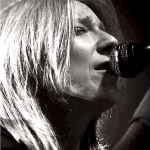
|

The Answer |
LATEST GALLERY IMAGES

Charity Workers Massacred 
We Bombed A Hospital |
|
|


